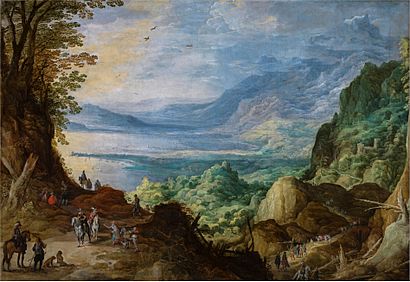Landscape with Sea and Mountains facts for kids
Quick facts for kids Landscape with Sea and Mountains |
|
|---|---|
 |
|
| Artist | Joos de Momper |
| Year | ca. 1623 |
| Catalogue | P001592 |
| Medium | Oil on canvas |
| Dimensions | 174 cm × 256 cm (68.5 in × 100.8 in) |
| Location | Museum of Prado, Madrid |
Landscape with Sea and Mountains is a famous oil on canvas painting. It was created by the Flemish artist Joos de Momper around 1623. Today, you can see this artwork at the Museum of Prado in Madrid, Spain.
About the Painting
Joos de Momper was known for painting amazing landscapes. He often included small figures of everyday people doing normal activities in his large scenes. He had some favorite ways of painting that he used often. These were very popular in Flanders at the time.
One of his favorite styles was to show a huge landscape with tiny people in the front. In this painting, you can spot hunters, beggars, and riders. They are all busy with their daily lives.
Look closely at the background! You'll see a vast view of mountains that seem to blend into the ocean. There's also a beautiful gulf (a large bay) that stretches out. This part of the painting really shows how creative Joos de Momper was. Flanders, where he lived, is mostly flat land. So, these tall, dramatic mountains came from his imagination!
Momper was part of a group of artists called Baroque Flemish landscapists. They liked to paint big, fantastical scenes that looked a bit old-fashioned. These paintings almost always featured mountains and exotic places. While some artists painted more realistic landscapes, painters like de Momper created these imaginary worlds. People with sophisticated tastes, like wealthy art collectors, loved these paintings and paid more for them.
You can also see the influence of another famous painter, Pieter Bruegel the Elder, in this artwork. One clear sign is the high horizon line, which was a common feature in Bruegel's works.
History of the Painting
This painting has a long and interesting history. It has been part of the Spanish Royal Collection for a very long time, at least since the early 1700s. In 1700, the painting was kept at the Buen Retiro Palace in Madrid. Today, it is proudly displayed in the Museum of Prado, also in Madrid.
See also
 In Spanish: Paisaje de mar y montañas para niños
In Spanish: Paisaje de mar y montañas para niños

